| dc.description.abstract | Ecological rarity, characterized by low abundance or limited distribution, is typical of most species, yet our understanding of what factors contribute to the persistence of rare species remains limited. Consequently, little is also known about whether rare species might respond differently than common species to direct (e.g., abiotic) and indirect (e.g., biotic) effects of climate change. We investigated the effects of warming and exclusion of large herbivores on 14 tundra taxa, three of which were common and 11 of which were rare, at an inland, low-arctic study site near Kangerlussuaq, Greenland. Across all taxa, pooled commonness was reduced by experimental warming, and more strongly under herbivore exclusion than under herbivory. However, taxon-specific analyses revealed that although warming elicited variable effects on commonness, herbivore exclusion disproportionately reduced the commonness of rare taxa. Over the 15-year duration of the experiment, we also observed trends in commonness and rarity under all treatments through time. Sitewide commonness increased for two common taxa, the deciduous shrubs Betula nana and Salix glauca, and declined in six other taxa, all of which were rare. Rates of increase or decline in commonness (i.e., temporal trends over the duration of the experiment) were strongly related to baseline commonness of taxa early in the experiment under all treatments except warming with grazing. Hence, commonness itself may be a strong predictor of species’ responses to climate change in the arctic tundra biome, but large herbivores may mediate such responses in rare taxa, perhaps facilitating their persistence. | en_US |

